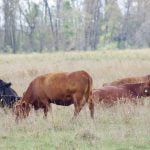Based on margin average | High reference prices mean if income declines, the program pays out
Recent years of higher farm sector commodity prices have restored AgriStability reference margin levels and made governments susceptible to higher future farm payments even as they look for deficit-fighting cost savings.
Through years of low prices in the grain sector and later cattle and hog sectors, the AgriStability program and its predecessor Canadian Agricultural Income Stabilization program became less effective because payments are triggered based on historic income.
Farmers have complained that years of low returns can reduce the reference margin average so much that payments are difficult to trigger when sectors need them the most.
Read Also

Canadian farmers need level playing field for regulations – says Minister MacDonald
Federal agriculture minister Heath MacDonald is urging the Canadian Food Inspection Agency and the Pest Management Regulatory Agency to speed up their decision making.
Recent years of good returns have made the program more robust and useful when future income declines occur, at least in grain and cattle sectors, government and industry players said in interviews. Hog industry reference margins after years of losses still are too low to make the program effective.
“The margin system in the hog industry isn’t there right now and AgriStability probably is doing very little for hog people because it has been too long of a dip,” said Manitoba farmer and safety net specialist Owen McAuley.
“But on the grain side in the area where we farm on the Saskatchewan border, we have established very good margins in the last few years and because we didn’t get a lot of acres seeded this year because it was too wet, I expect those margins will pay us big dividends.”
Agriculture Canada agrees.
Departmental economists have developed a model that predicts AgriStability payments of more than $1.6 billion if there is a grain sector income decline in 2015, more than double predicted payments if there is no sharp industry income decline.
“In the grains and oilseeds sector, reference margins right now are very high, so when there is a future dip against that reference margin, the program will pay out, so it is completely foreseeable that a sector that is doing well but not as well as in the past five years will be getting payments,” Agriculture Canada assistant deputy minister Greg Meredith said.
“Across the board, margins are being built up and even in hogs, the trend is up.”
Stewart Skinner, a hog producer from Listowel, Ont., said that despite better sector returns, the years of losses have made the AgriStability program largely unhelpful.
Part of the problem is that the reference margin formula takes the past five year average income as the trigger with the highest and lowest year excluded.
“We have not rebuilt our margins yet,” said Skinner in an interview during a national farm policy conference in Ottawa Jan. 12.
“For most hog farmers, the 2011 calendar year should be positive, but with the Olympic average that drops the high year, it is out of the formula so we still have negative margins. If we have a sudden downturn, AgriStability will not function as it was meant to function.”
University of Saskatchewan agricultural economist Richard Gray said the recent boom years in most sectors have made the AgriStability program a more robust support when the inevitable low-income years return. He is predicting a decline in grain prices within a few years.
“Farmers who have had both high prices and high yields have built up some incredible margins in the grain and oilseed sector,” he said.
“That protects farmers from the next shock, but it also creates incredible exposure for governments. The cattle industry is building margins and a couple more good years should do it. Hog producers who have had the worst time in recent years remain the least protected by the program.”
The potential for bigger program payments comes at a time when federal and provincial governments that share the financial obligation are looking for ways to cut spending. In Ottawa, all departments have been told to find five to 10 percent savings to be included in the March budget.
However, Meredith said that because the business risk management programs are enshrined in law and must respond when there is industry demand, it does not affect Agriculture Canada’s cost-cutting obligations.
“These are statutory demand-driven programs so it isn’t really Agriculture Canada budgets that are affected,” he said. “It comes out of the fiscal framework (of general revenues).”














